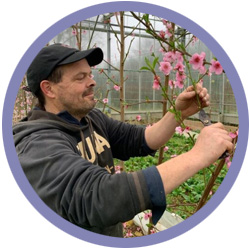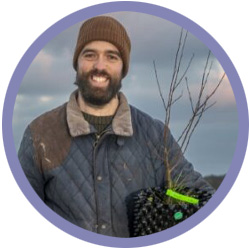- Soil Association
- Farmers & growers
- Low-input farming advice
- Agroforestry on your farm
- Meet our ambassadors

Meet our agroforestry ambassadors
Meet our growing team of agroforestry ambassadors
 Ben Andrews
Ben Andrews
Mixed organic farm (beef, arable, vegetables)
Leominster, Herefordshire
We already have some grazed woodland of various densities on the farm and are really keen to increase the area as I have seen first hand the benefits of trees in a farmed landscape. The trees provide food and shelter for the livestock whilst sequestering carbon, filtering air, aiding water infiltration and boosting biodiversity. And the stock can help improve habitat for a whole host of bugs, birds and beasts that live in, on or under trees. You can’t lose.
 Andy Dibben
Andy Dibben
Mixed Organic Farm - vegetables, fruit, livestock, dairy and arable
The Organic Farm Shop, Abbey Home Farm, Cirencester, Gloucestershire
Agroforestry Type - Silvohorticulture
Agroforestry offers an amazing range of potential tools to improve horticultural production - the more I learn about it, the more ways I can envisage using it. Reducing wind speeds in outdoor cropping areas, proactively managing insect predators to protect my vegetable crops and providing shade in protected cropping areas are all techniques I currently use agroforestry for at the farm.
Looking to the future I am interested in using agroforestry to manage increasingly intense rain patterns and to increase our range of perennial crop lines to establish greater resilience against the effects of climate change.
Abbey Home Farm prides itself on engaging with people from all walks of life and educating and sharing knowledge wherever possible. Agroforestry is a fantastic way to further develop our educational offering. Whether that's simply teaching young children about the importance of trees to our planet, or educating experienced farmers on the wide range of benefits agroforestry can offer their farms, whatever they produce and at any scale.
 Hannah Fraser
Hannah Fraser
Organic arable farm, 450 acres
Denby Hall Farm, near Cawthorne, South Yorkshire
Early in 2023, we planted 3000 trees and wildflower strips within a 50-acre arable field, creating an 'alley cropping' system. We planted a mix of hazel, sweet chestnut, sycamore and alder, with the aim of coppicing the trees and harvesting the timber. Since my husband and I took over the farm in 2018, our ambition has been to regenerate the farm’s living ecosystem and embrace the ecological benefits that land can provide, whilst still growing nutritious food for people. I think our agroforestry system is a key part of how we can achieve this. Whilst the trees are still only young, we've already seen a bloom of wildlife inhabiting the wild flower understorey. We hope that as the trees grow, they will improve water drainage, help increase resilience to droughts, shield strong winds, promote soil life and ultimately help us to produce high quality organic milling cereals, whilst providing great ecosystem services.
 David Oates
David Oates
Mixed, livestock, arable, field trials, species rich grassland, lowland heathland and woodland
250 acres owned and another 1000 contract farmed & rented
Rosuick Farm, Lizard Peninsula, Cornwall
I've always had a keen interest in trees, inherited from my dad. Our farm used to be covered in Cornish elms. We had the biggest elm tree in Britain but this along with many others were lost to Dutch elm disease. My dad built a saw mill and from a young age I remember the satisfaction of cutting and building with home-grown timber.
Now with a commercial focus of sustainable beef and lamb production, agroforestry is to perfect way to get more trees onto our farm. Increasing output of our land, producing more food, while cutting costs and increasing efficiency without giving up productive land for woodland are obvious goals agroforestry can deliver. These along with the wide array of environmental benefits make it fit perfectly with the environmental ethos of our business.
I have designed our agroforestry systems to showcase as many forms of agroforestry as I can, to make the most of the full range of benefits and be able to share these with others.
Expanding our existing traditional orchards, creating new alley cropping, wood pasture and parklands is exciting to see develop. Shelter belts and strategically planted areas enhance the welfare of livestock and I hope that in the future these practices will add value to the end consumer for the food we produce on farm.
 George Young
George Young
Beef suckler
Curtis Farm, Fobbing, Essex
Agroforestry is a natural fit for the nature-focussed farming system at Curtis Farm. The farm has been designed with connectivity as the guiding principle, centred around a ‘wild seam’ which runs through the middle of the farm and connects each field. Agroforestry works tremendously well for dividing fields up into logical chunks, with the tree belts providing yet more incredible habitat for wildlife. Over the coming years, the trees themselves will continue to offer shade and shelter to livestock. Even more, the trees diversify the forage available to the cows, enabling the animals a degree of self-medication. To be really simplistic though, adding trees to any farm just massively increases the beauty of the land.
